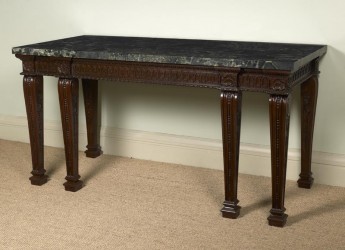Unusual carved mahogany side table with marble top
Unusual carved mahogany side table with marble top, the frieze with a series of conjoined lancets, between a top moulding of stiff leaf within a lappet on a punched ground, and the lower, a variant of egg and dart, the legs headed by a double over-laid aqueous shell, the upright legs carved as elongated corbels, rather as masonry, the front mouldings centred by a bead and reel, neo-classic ornament at the sides, on square block feet. English, c. 1780. Replaced verde antico marble top.
Height 36¼" (92cm).
Width 70¾" (1,80m).
Depth 32¼" (82cm).
Provenance :- Boughton Monchelsea Place, Kent. The history of the house dates back to before the Norman Conquest, when it was owned by the Saxon Earl Godwin. It was subsequently given by William the Conqueror to his half-brother Odo, Bishop of Bayeux. The house in its present form dates from the late-16th Century, when it was owned by Robert Rudston. In the late-17th Century the house was inherited by Thomas Rider, and it descended in his family until 1903, when it was bought by Lt-Col. G. B. Winch, whose family owned it until recently. Previously, this table might have been one of a pair from Yotes Court, Kent, the seat of the Viscounts Torrington, sold at auction on the premises, October 1st-3rd 1923. Lt.-Col. Winch bought no less than 40 lots in the sale at Yotes Court, and it is tempting to identify this present table with one of a pair of tables sold from the Dining Room as lots 507 and 508 :- ‘A 5ft. 10in. ADAMS MAHOGANY CARVING TABLE, the frieze to front and ends with carved flutings and cartouches, on 6 legs’, and ‘THE COMPANION CARVING TABLE’ (108 guineas for the two). These two lots were apparently sold together, the tables being bought at the sale by the London dealers, Partridge, and not by Lt.-Col. Winch, but it is not hard to imagine that, wanting only one, he might have subsequently acquired one of them from Partridge.
The design of paired legs fronting a six-legged side table seems to have appeared from just before the middle of the 18th Century, and the form was continued by the best-known designers and craftsmen, such as Adam, Chippendale, and Mayhew and Ince. Chippendale’s Director has a design for a ‘Sideboard Table’ of very similar form to the present table, though with canted corners.(1) An early example of the form, of the early-1740s, of the same scale as the present table, the frieze keyed-out at the front only, the back legs entirely reversed, is in the Hall at Stourhead, Wiltshire, now belonging to the National Trust.(2) A pair, also of similar form and scale, and dated c. 1740, was sold from Much Hadham Hall, Hertfordshire.(3) Other mid-Century tables of this type are in the Hall at Newby Hall, Yorkshire,(4) one formerly at Stanmer House, Brighton,(5) one at Kelmarsh Hall, Northamptonshire,(6) and a group of five white-painted side tables, of various sizes, at Petworth House, West Sussex, the largest of which is listed in a 1764 inventory of the house. Another example of this upright leg with scrolled top, emerging from the frieze in the same way, was on a mid-18th Century library table with paired legs of this type, previously owned by George Widener,(7) and an eight-legged pair of side tables with marble tops in the collection of the Huntingdon Art Gallery, San Marino, California have very similar legs and feet.(8) The unusual carving on the frieze of this present table is related to a frieze of differently conjoined lancets on a bookcase attributed to William Vile from the collection of Sir James Caird.(9)
_________________
Footnotes
1) Thomas Chippendale, The Gentleman & Cabinet-Maker’s Director, Third Edition, 1762, Plate LXI.
2) Christopher Hussey, English Country Houses, Mid-Georgian, 1760-1800, rev. ed., 1963, fig. 484, p. 235.
3) Sotheby’s, Much Hadham Hall, 30th September - 1st October 1980, lot 667. Now in a private collection, London.
4) Eileen Harris, The Genius of Robert Adam, 2001, p. 226.
5) C. Musgrave, Adam and Hepplewhite, and other Neo Classical Furniture, 1966, no. 13.
6) See Country Life, June 4th 2008, fig. 3, p. 161.
7) Christie’s New York, English Furniture, October 22nd 1988, lot 144 ($165,000, R. A. Lee).
8) See Robert R. Wark, The Huntingdon Art Collection, 1970, no. 121, p. 81.
9) Ralph Edwards and Margaret Jourdain, Georgian Cabinetmakers, c. 1700-1800, rev. ed., 1955, no. 59, p. 150.





